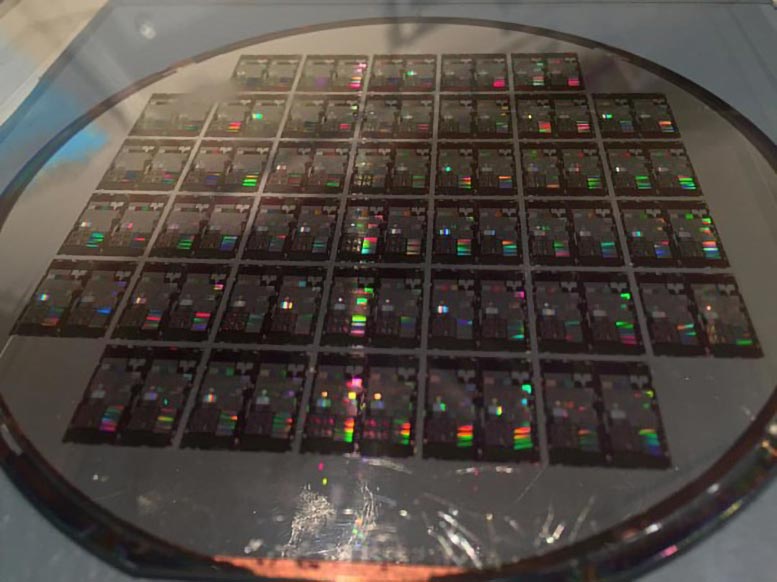A cutting-edge AI acceleration platform powered by light rather than electricity could revolutionize how AI is trained and deployed.
Using photonic integrated circuits made from advanced III-V semiconductors, researchers have developed a system that vastly outperforms traditional silicon GPUs in both energy efficiency and speed. This technology could not only lower energy costs but also scale AI to new levels of performance, potentially transforming everything from data centers to future smart systems.
The AI Boom and Its Infrastructure Challenges
Artificial intelligence (AI) is rapidly transforming a wide range of industries. Powered by deep learning and vast datasets, AI systems require enormous computing power to train and operate. Today, most of this work relies on graphical processing units (GPUs), but their high energy consumption and limited scalability pose significant challenges. To support future growth in AI, more efficient and sustainable hardware solutions are needed.
A Leap Forward: Photonic Circuits for AI
A recent study published in the IEEE Journal of Selected Topics in Quantum Electronics introduces a promising alternative: an AI acceleration platform built on photonic integrated circuits (PICs). These optical chips offer better scalability and energy efficiency than traditional, GPU-based systems. Led by Dr. Bassem Tossoun, Senior Research Scientist at Hewlett Packard Labs, the research shows how PICs that incorporate III-V compound semiconductors can run AI workloads faster and with far less energy.
Unlike conventional hardware, which uses electronic distributed neural networks (DNNs), this new approach uses optical neural networks (ONNs), circuits that compute with light instead of electricity. Because they operate at the speed of light and minimize energy loss, ONNs hold great potential for accelerating AI more efficiently.

"While silicon photonics are easy to manufacture, they are difficult to scale for complex integrated circuits. Our device platform can be used as the building blocks for photonic accelerators with far greater energy efficiency and scalability than the current state-of-the-art," explains Dr. Tossoun.
The team used a heterogeneous integration approach to fabricate the hardware. This included the use of silicon photonics along with III-V compound semiconductors that functionally integrate lasers and optical amplifiers to reduce optical losses and improve scalability. III-V semiconductors facilitate the creation of PICs with greater density and complexity. PICs utilizing these semiconductors can run all operations required for supporting neural networks, making them prime candidates for next-generation AI accelerator hardware.
How the Platform Was Fabricated
The fabrication started with silicon-on-insulator (SOI) wafers that have a 400 nm-thick silicon layer. Lithography and dry etching were followed by doping for metal oxide semiconductor capacitor (MOSCAP) devices and avalanche photodiodes (APDs). Next, selective growth of silicon and germanium was performed to form absorption, charge, and multiplication layers of the APD. III-V compound semiconductors (such as InP or GaAs) were then integrated onto the silicon platform using die-to-wafer bonding. A thin gate oxide layer (Al₂O₃ or HfO₂) was added to improve device efficiency, and finally a thick dielectric layer was deposited for encapsulation and thermal stability.
A New Frontier in AI Hardware
"The heterogeneous III/V-on-SOI platform provides all essential components required to develop photonic and optoelectronic computing architectures for AI/ML acceleration. This is particularly relevant for analog ML photonic accelerators, which use continuous analog values for data representation," Dr. Tossoun notes.
This unique photonic platform can achieve wafer-scale integration of all of the various devices required to build an optical neural network on one single photonic chip, including active devices such as on-chip lasers and amplifiers, high-speed photodetectors, energy-efficient modulators, and non-volatile phase shifters. This enables the development of TONN-based accelerators with a footprint-energy efficiency that is 2.9 × 10² times greater than other photonic platforms and 1.4 × 10² times greater than the most advanced digital electronics.
Transforming AI with Light-Speed Efficiency
This is indeed a breakthrough technology for AI/ML acceleration, reducing energy costs, improving computational efficiency, and enabling future AI-driven applications in various fields. Going forward, this technology will enable datacenters to accommodate more AI workloads and help solve several optimization problems.
The platform will be addressing computational and energy challenges, paving the way for robust and sustainable AI accelerator hardware in the future!
Reference: "Large-Scale Integrated Photonic Device Platform for Energy-Efficient AI/ML Accelerators" by Bassem Tossoun, Xian Xiao, Stanley Cheung, Yuan Yuan, Yiwei Peng, Sudharsanan Srinivasan, George Giamougiannis, Zhihong Huang, Prerana Singaraju, Yanir London, Matěj Hejda, Sri Priya Sundararajan, Yingtao Hu, Zheng Gong, Jongseo Baek, Antoine Descos, Morten Kapusta, Fabian Böhm, Thomas Van Vaerenbergh, Marco Fiorentino, Geza Kurczveil, Di Liang and Raymond G. Beausoleil, 9 January 2025, IEEE Journal of Selected Topics in Quantum Electronics.
DOI: 10.1109/JSTQE.2025.3527904
News
Scientists Melt Cancer’s Hidden “Power Hubs” and Stop Tumor Growth
Researchers discovered that in a rare kidney cancer, RNA builds droplet-like hubs that act as growth control centers inside tumor cells. By engineering a molecular switch to dissolve these hubs, they were able to halt cancer [...]
Platelet-inspired nanoparticles could improve treatment of inflammatory diseases
Scientists have developed platelet-inspired nanoparticles that deliver anti-inflammatory drugs directly to brain-computer interface implants, doubling their effectiveness. Scientists have found a way to improve the performance of brain-computer interface (BCI) electrodes by delivering anti-inflammatory drugs directly [...]
After 150 years, a new chapter in cancer therapy is finally beginning
For decades, researchers have been looking for ways to destroy cancer cells in a targeted manner without further weakening the body. But for many patients whose immune system is severely impaired by chemotherapy or radiation, [...]
Older chemical libraries show promise for fighting resistant strains of COVID-19 virus
SARS‑CoV‑2, the virus that causes COVID-19, continues to mutate, with some newer strains becoming less responsive to current antiviral treatments like Paxlovid. Now, University of California San Diego scientists and an international team of [...]
Lower doses of immunotherapy for skin cancer give better results, study suggests
According to a new study, lower doses of approved immunotherapy for malignant melanoma can give better results against tumors, while reducing side effects. This is reported by researchers at Karolinska Institutet in the Journal of the National [...]
Researchers highlight five pathways through which microplastics can harm the brain
Microplastics could be fueling neurodegenerative diseases like Alzheimer's and Parkinson's, with a new study highlighting five ways microplastics can trigger inflammation and damage in the brain. More than 57 million people live with dementia, [...]
Tiny Metal Nanodots Obliterate Cancer Cells While Largely Sparing Healthy Tissue
Scientists have developed tiny metal-oxide particles that push cancer cells past their stress limits while sparing healthy tissue. An international team led by RMIT University has developed tiny particles called nanodots, crafted from a metallic compound, [...]
Gold Nanoclusters Could Supercharge Quantum Computers
Researchers found that gold “super atoms” can behave like the atoms in top-tier quantum systems—only far easier to scale. These tiny clusters can be customized at the molecular level, offering a powerful, tunable foundation [...]
A single shot of HPV vaccine may be enough to fight cervical cancer, study finds
WASHINGTON -- A single HPV vaccination appears just as effective as two doses at preventing the viral infection that causes cervical cancer, researchers reported Wednesday. HPV, or human papillomavirus, is very common and spread [...]
New technique overcomes technological barrier in 3D brain imaging
Scientists at the Swiss Light Source SLS have succeeded in mapping a piece of brain tissue in 3D at unprecedented resolution using X-rays, non-destructively. The breakthrough overcomes a long-standing technological barrier that had limited [...]
Scientists Uncover Hidden Blood Pattern in Long COVID
Researchers found persistent microclot and NET structures in Long COVID blood that may explain long-lasting symptoms. Researchers examining Long COVID have identified a structural connection between circulating microclots and neutrophil extracellular traps (NETs). The [...]
This Cellular Trick Helps Cancer Spread, but Could Also Stop It
Groups of normal cbiells can sense far into their surroundings, helping explain cancer cell migration. Understanding this ability could lead to new ways to limit tumor spread. The tale of the princess and the [...]
New mRNA therapy targets drug-resistant pneumonia
Bacteria that multiply on surfaces are a major headache in health care when they gain a foothold on, for example, implants or in catheters. Researchers at Chalmers University of Technology in Sweden have found [...]
Current Heart Health Guidelines Are Failing To Catch a Deadly Genetic Killer
New research reveals that standard screening misses most people with a common inherited cholesterol disorder. A Mayo Clinic study reports that current genetic screening guidelines overlook most people who have familial hypercholesterolemia, an inherited disorder that [...]
Scientists Identify the Evolutionary “Purpose” of Consciousness
Summary: Researchers at Ruhr University Bochum explore why consciousness evolved and why different species developed it in distinct ways. By comparing humans with birds, they show that complex awareness may arise through different neural architectures yet [...]
Novel mRNA therapy curbs antibiotic-resistant infections in preclinical lung models
Researchers at the Icahn School of Medicine at Mount Sinai and collaborators have reported early success with a novel mRNA-based therapy designed to combat antibiotic-resistant bacteria. The findings, published in Nature Biotechnology, show that in [...]





















